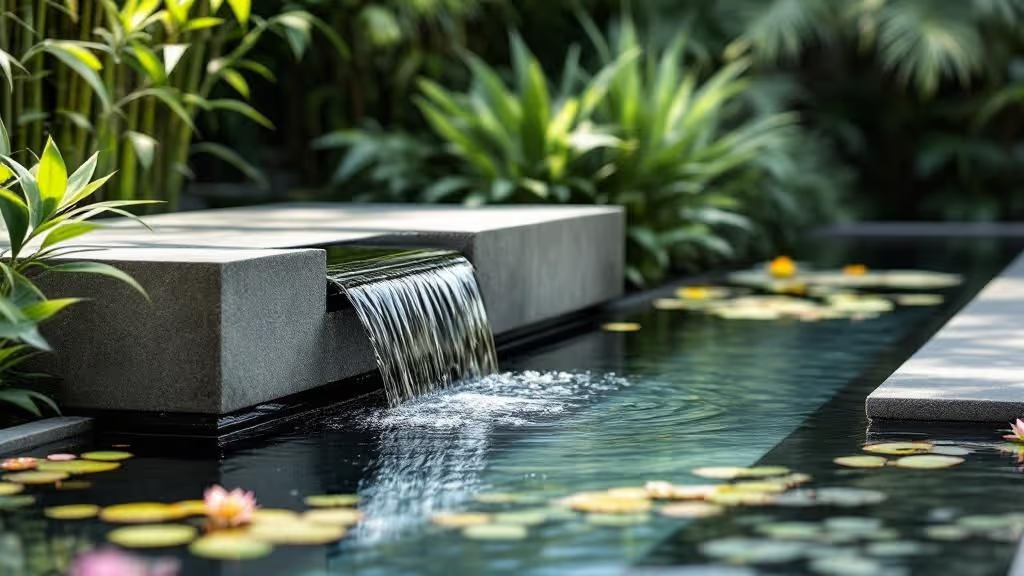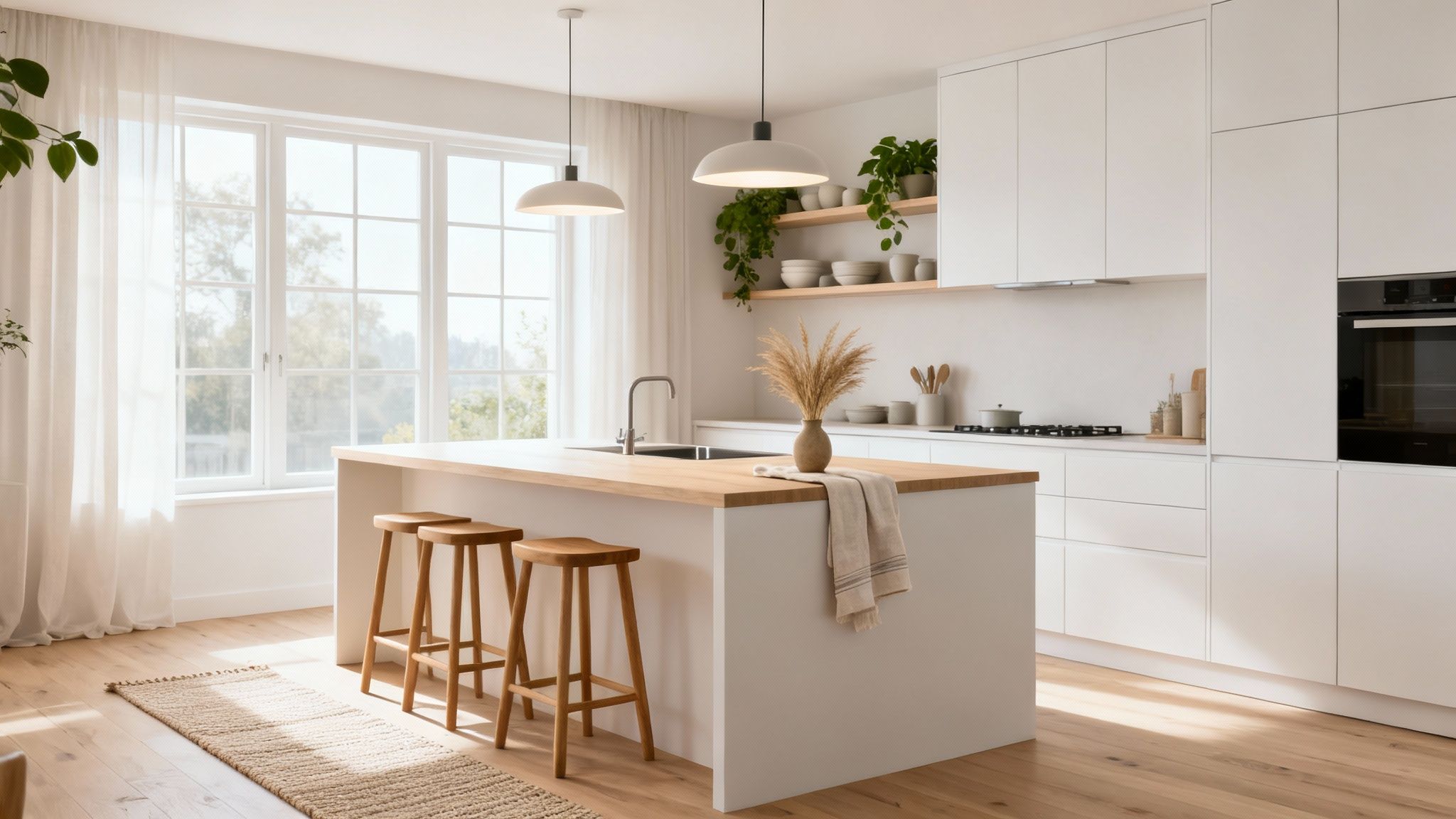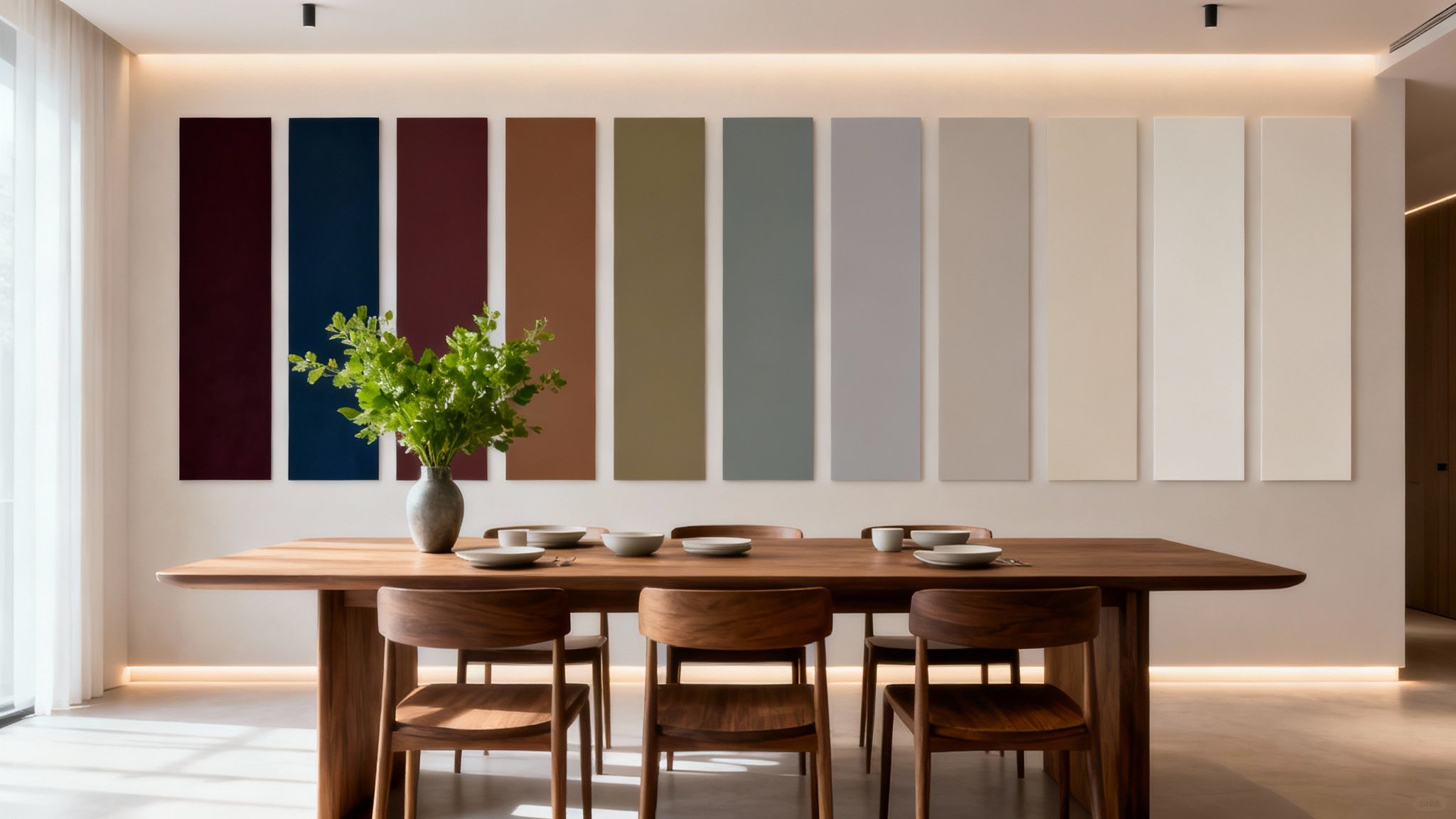Imagine stepping into your garden and being greeted by the soothing sound of flowing water - a gentle cascade, a tranquil pond reflecting the sky, or a sleek channel guiding your eye through the landscape. A garden with water feature does more than just add visual appeal; it transforms an ordinary space into an immersive, multi-sensory retreat. The sound of water can mask unwanted neighbourhood noise, creating a genuine sense of peace and seclusion right outside your door. It also attracts beneficial wildlife, such as birds and dragonflies, adding another layer of life and movement to your personal oasis.
However, with countless styles to consider, finding the perfect fit for your space and aesthetic can feel overwhelming. Are you drawn to the serene simplicity of a Japanese Zen garden, the bold architectural lines of a contemporary rill, or the organic beauty of a natural swimming pond? This guide is organised to help you explore the possibilities without the guesswork. We've curated seven distinct and inspiring water feature ideas, each complete with practical insights on design, installation, suitable plant pairings, and maintenance tips. Let's dive in and discover how to bring the unique magic of water to your own outdoor haven.
1. Japanese Zen Water Garden
A Japanese Zen water garden transcends being merely a garden; it's a meticulously crafted sanctuary designed to inspire peace, meditation, and a deep connection with nature. This ancient design philosophy uses water as a central, life-giving element to create a tranquil atmosphere. The gentle sound of trickling water from a bamboo shishi-odoshi (deer-scarer), the serene surface of a koi pond, or the quiet stillness of a stone basin (tsukubai) are all intended to calm the mind and soothe the soul. This style emphasises natural materials like stone, wood, and bamboo, alongside carefully chosen plants to create a harmonious and balanced environment. It's an ideal choice for anyone seeking to create a restorative retreat in their outdoor space.
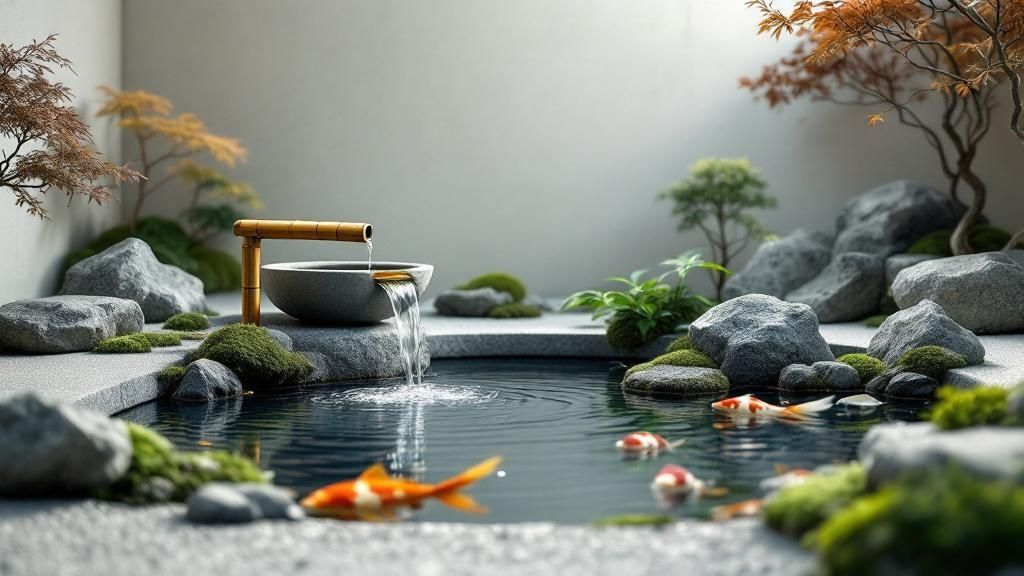
Creating Your Zen Space
Integrating this style into your garden with a water feature can feel ambitious, but starting small is key. Begin with a single focal point, such as a simple stone basin or a small, self-contained bamboo fountain. This allows you to capture the essence of the style without requiring a complete garden overhaul. As you become more confident, you can expand to more complex features like a small pond or a dry stream bed (karesansui) that uses raked gravel to symbolise water. The goal is to create a scene that looks both natural and intentionally peaceful.
Key Implementation Tips
To successfully create your own Japanese-inspired water garden, consider these practical steps:
- Plant Selection: Combine traditional Japanese plants like acers (Japanese maples), hostas, and mosses with hardy native species that thrive in your local climate. This ensures a lush, healthy garden that respects the aesthetic. For more inspiration on creating beautiful edges, discover some complementary garden border plant ideas from Spruce Collective.
- Thoughtful Placement: Position your water feature where it can be seen and heard from a seating area, such as a small bench or a series of stepping stones. This creates a dedicated space for reflection and enjoyment.
- Koi Pond Care: If you introduce a koi pond, invest in a high-quality filtration system. Proper filtration is crucial for maintaining water clarity and ensuring the health of the fish, which are central to the garden's vitality.
- Embrace Asymmetry: Avoid perfect symmetry. Japanese garden design values natural, asymmetrical balance to create a more dynamic and interesting composition.
2. Contemporary Rill Water Feature
A contemporary rill is a modern interpretation of a classical water channel, creating a sleek, linear feature that brings structure and sophistication to a garden. These narrow waterways guide the eye, define spaces, and introduce the subtle, calming sound of moving water. Often constructed from materials like polished concrete, Corten steel, or smooth-cut stone, rills add a strong geometric element that contrasts beautifully with soft planting. This style is perfect for those who appreciate clean lines, minimalist design, and an architectural approach to their garden with a water feature, turning a simple path into a dynamic, reflective journey.
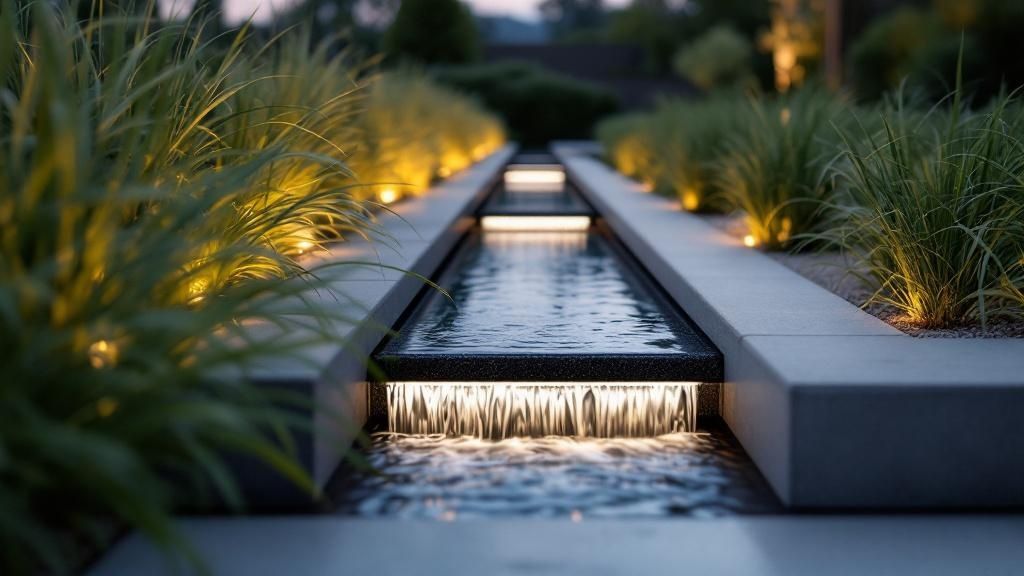
Creating Your Modern Waterway
Designing a rill is about precision and creating a seamless connection with the surrounding landscape. It can act as a formal canal leading to a focal point, such as a sculpture or seating area, or it can run alongside a pathway to create a sensory experience. The beauty of a rill lies in its simplicity; the straight lines and reflective surface offer a sense of order and tranquillity. The design can be as simple as a shallow channel set flush with a patio or as complex as a multi-level feature that cascades gently down a slope. This feature elevates a garden's design from ordinary to highly curated.
Key Implementation Tips
To successfully integrate a contemporary rill into your garden design, consider these practical points:
- Material Cohesion: Use materials for the rill that complement your home's architecture and existing hardscaping. Consistency in your material palette creates a unified, high-end look.
- Subtle Level Changes: Incorporate very slight changes in elevation along the rill's length. This will create gentle water movement and a soft, trickling sound without being disruptive.
- Architectural Planting: Pair the clean lines of the rill with bold, structural plants like ornamental grasses, phormiums, or boxwood spheres. This contrast between hardscape and softscape is a hallmark of modern garden design. For more on cutting-edge garden concepts, explore these emerging garden trends for 2025 from Spruce Collective.
- Circulation and Safety: Ensure the rill is designed with a closed-loop pump system for water circulation and includes proper drainage and overflow mechanisms. If it's in a high-traffic area, consider its depth for safety.
3. Natural Swimming Pool Garden
A natural swimming pool garden offers a revolutionary, eco-friendly alternative to traditional chlorinated pools, merging recreation with ecological design. This innovative concept uses a carefully balanced ecosystem of aquatic plants and beneficial micro-organisms to filter and clean the water, completely eliminating the need for harsh chemicals. The result is a stunning garden with a water feature that mimics a natural pond or swimming hole, providing a crystal-clear, chemical-free swimming experience. It's a perfect choice for those who desire a swimming area that blends seamlessly into the landscape and supports local biodiversity.
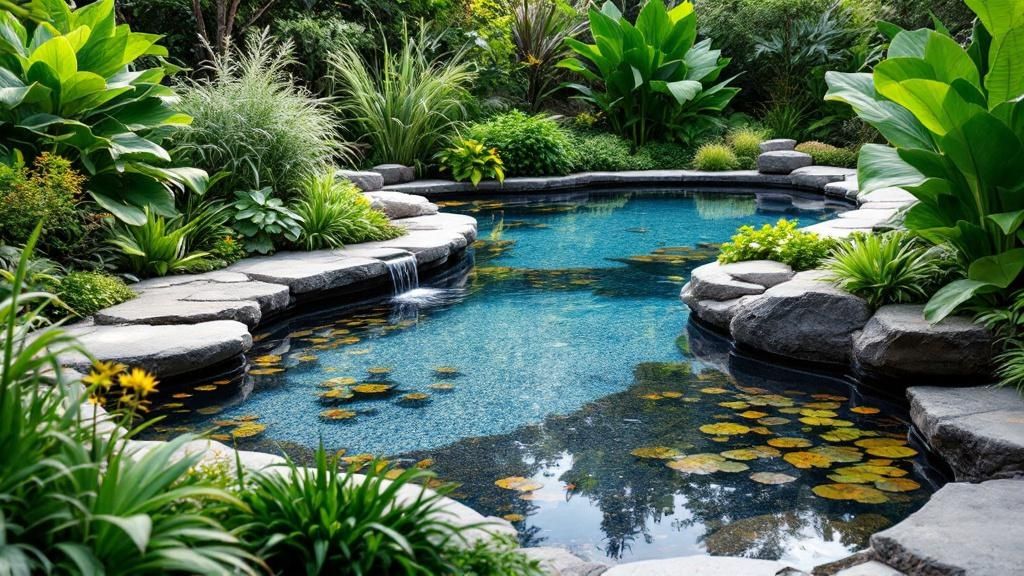
Creating Your Eco-Friendly Oasis
Integrating a natural swimming pool requires a different approach to a standard pool installation. The system is divided into two main zones: a swimming area and a regeneration zone where plants do the work of filtration. Water is circulated between these two areas, often using a small, energy-efficient pump, ensuring it remains clean and oxygenated. This creates a living water feature that is not only beautiful year-round but also provides a habitat for wildlife like dragonflies and frogs, enhancing the natural feel of your garden.
Key Implementation Tips
To successfully create your own natural swimming pool, careful planning and execution are essential. Consider these practical steps:
- Allocate Space Correctly: Plan for the regeneration zone to occupy approximately 50-70% of the total pool area. This ensures there is enough plant life and surface area for effective biological filtration.
- Select Diverse Plants: Use a variety of aquatic plants, including submerged oxygenators, floating plants, and marginals like water irises and reeds. A diverse ecosystem is more resilient and effective at maintaining water quality.
- Ensure Proper Circulation: A well-designed circulation system is vital. It gently moves water from the swimming zone through the plant filter and back, preventing stagnation and ensuring all water is properly cleaned.
- Consult with Experts: Constructing a natural pool is a specialised task. Engage with experienced designers, such as those at Clear Water Revival or BioNova, to ensure the system is correctly designed and balanced for your specific site and climate. For those looking to create a beautiful yet manageable outdoor space, you can discover complementary low-maintenance garden ideas from Spruce Collective.
4. Multi-Level Waterfall Garden
A multi-level waterfall garden introduces a sense of drama and natural grandeur into any outdoor space. This dynamic design uses elevation changes, whether natural or constructed, to create a cascade of water that flows through multiple tiers. The resulting feature offers both a powerful visual spectacle and a rich auditory experience, from a gentle, soothing trickle to a more vigorous, resonant cascade. Often built with natural stone and lush plantings, this type of garden with a water feature mimics the majestic beauty of a mountainside stream, turning a sloped or even a flat garden into a captivating, multi-sensory environment. It is an excellent choice for those looking to make a bold statement and create a truly immersive natural escape.
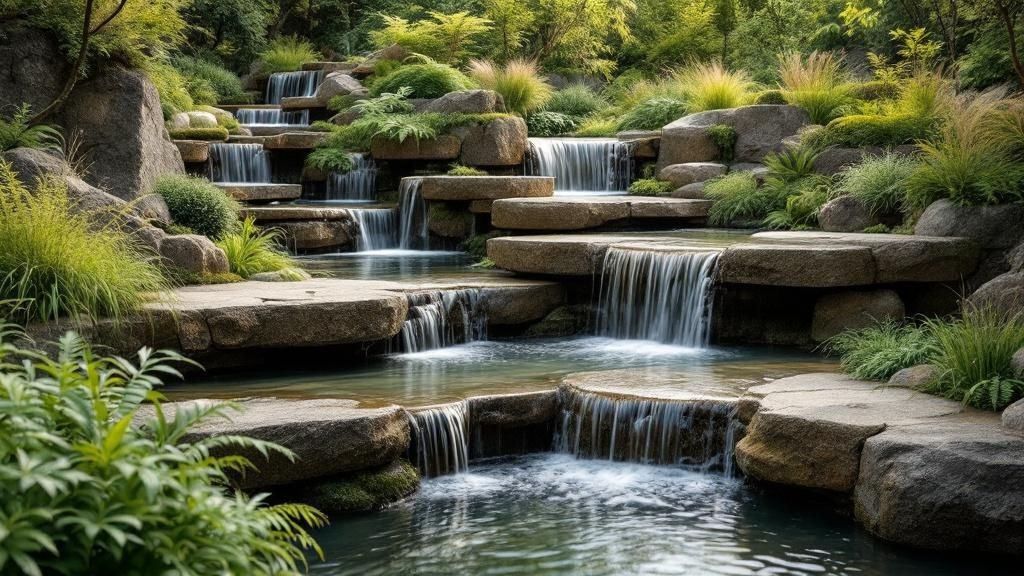
Creating Your Cascading Oasis
Designing a multi-level waterfall might seem complex, but the key is to work with your garden's existing topography. If you have a natural slope, it provides the perfect foundation for a cascading water feature. For flatter spaces, you can build up the levels using retaining walls and earth berms to create the necessary height difference. The goal is to make the waterfall look as though it has always been a part of the landscape, integrating it seamlessly with rocks, soil, and plants to establish a cohesive and impressive centrepiece.
Key Implementation Tips
To successfully construct a stunning multi-level waterfall garden, focus on these practical considerations:
- Utilise Slopes: Always start by assessing your garden for any existing slopes or grade changes. Leveraging a natural incline will reduce construction costs and create a more authentic-looking feature.
- Source Local Stone: Use natural stone that complements your local geology for the most harmonious appearance. This ensures the waterfall feels rooted in its environment rather than looking like an artificial addition.
- Plan Water Circulation: A powerful, reliable pump and an effective filtration system are essential. Ensure the system is sized correctly to push water to the top level and maintain clarity, preventing algae buildup and debris.
- Incorporate Planting Pockets: Design small pockets within the stone structure for planting. Trailing plants, ferns, and mosses soften the rockwork and help integrate the waterfall into the surrounding garden. Many of the principles used for vertical planting can also be applied here, providing more ideas for your integrated garden wall feature.
5. Reflective Pool Garden
A reflective pool garden is the epitome of formal elegance, using a perfectly still surface of water to create a living mirror. This design transforms a garden with a water feature into a sophisticated landscape, reflecting the sky, surrounding architecture, and carefully curated plantings. Unlike features that focus on sound and movement, the reflective pool’s power lies in its tranquillity and its ability to create a sense of depth and grandeur. The mirror-like surface captures the changing light throughout the day, from the crisp blue of a morning sky to the warm glow of sunset, making the garden a dynamic and captivating space. It is a timeless choice for those seeking to instil a sense of order, drama, and contemplative quiet in their outdoor sanctuary.
Creating Your Mirrored Masterpiece
Introducing a reflective pool requires precision and careful planning, as its success depends entirely on its stillness and clarity. The pool is often designed with simple, geometric shapes like rectangles or circles, acting as the central organising element in a formal garden layout. The key is to create a feature where the water level is as close to the coping edge as possible, enhancing the seamless, mirror-like effect. This style is less about bustling aquatic life and more about pure, uninterrupted reflection, creating a powerful visual anchor that doubles the impact of its surroundings.
Key Implementation Tips
To achieve the stunning effect of a reflective pool garden, consider these essential steps:
- Dark Finishes: Use dark interior finishes for the pool, such as black or dark grey tiles or liners. A dark base absorbs more light, which dramatically enhances the water’s reflective quality and creates a deeper, more mirror-like surface.
- Strategic Positioning: Place the pool where it can capture the most compelling views. This could be a reflection of a beautiful specimen tree, a striking architectural feature of your home, or an open expanse of sky.
- Maintain Water Clarity: The mirror effect is lost if the water is murky. Invest in a robust filtration system designed to keep the water crystal clear and free of debris. Regular skimming, especially in autumn, is crucial.
- Subtle Lighting: Enhance the drama after dusk with subtle, underwater up-lighting or perimeter lighting. This will transform the pool into a captivating feature at night, reflecting both the lights and the stars.
6. Rain Garden with Water Harvesting
A rain garden is a clever, environmentally sustainable design that transforms a potential problem, stormwater runoff, into a beautiful garden feature. This approach involves creating a shallow, planted depression that captures rainwater from surfaces like rooftops, driveways, and patios. Instead of overwhelming storm drains, the water is held, filtered by soil and plant roots, and slowly absorbed back into the ground. This functional garden with a water feature not only prevents erosion and reduces local flooding but also creates a lush, thriving habitat for pollinators and wildlife. It’s an ideal solution for eco-conscious gardeners wanting to manage water responsibly while adding naturalistic beauty to their landscape.
Creating Your Functional Oasis
Building a rain garden combines thoughtful landscaping with practical water management. The core idea is to direct runoff to a specific, well-prepared area. You begin by excavating a shallow basin, typically with gently sloped sides, and filling it with a mixture of sand, compost, and soil to ensure excellent drainage. This allows the collected water to percolate into the ground within a day or two, preventing stagnant water and mosquito issues. The result is a dynamic, self-irrigating garden bed that flourishes after a downpour and remains attractive during dry spells, showcasing the principles of sustainable design.
Key Implementation Tips
To successfully construct a functional and beautiful rain garden, consider these practical steps:
- Correct Sizing: Design the garden to be large enough to handle the runoff from its contributing drainage area. A common guideline is to size it to manage at least the first inch of rainfall from the connected surfaces.
- Plant Selection: Choose native, deep-rooted plants that are adapted to your local climate. Select species that can tolerate periods of both inundation and drought, such as irises, sedges, and dogwood shrubs.
- Test Your Soil: Before you start digging, perform a soil infiltration test. This involves digging a hole, filling it with water, and timing how long it takes to drain. This helps you determine if your soil is suitable or needs amendment.
- Plan for Overflow: Incorporate an overflow point, such as a slightly lower edge leading to a drain or another safe area. This ensures that during exceptionally heavy rainfall, excess water has a planned escape route and doesn't flood surrounding areas.
7. Container Water Garden
A container water garden is a wonderfully versatile and accessible way to introduce the soothing presence of water into any outdoor area, regardless of its size. This method involves creating a miniature aquatic ecosystem within a vessel such as a large pot, a repurposed barrel, or a decorative trough. It offers a self-contained and often portable solution, perfect for patios, balconies, or small courtyards where a traditional pond isn't feasible. The beauty of this approach lies in its simplicity and adaptability; you can cultivate a variety of aquatic plants, install a small bubbler for gentle sound, and create a complete garden with a water feature in a single afternoon. It's the ideal choice for anyone wanting to experiment with water gardening on a manageable scale.
Creating Your Miniature Oasis
Building your own container water garden is an enjoyable and creative project. The key is selecting the right container; it must be watertight and large enough to support your chosen plants. An old zinc wash tub, a ceramic planter without drainage holes, or even a half-whisky barrel can be transformed into a stunning focal point. You can then layer aquatic soil, gravel, and arrange plants at different depths to create a balanced, thriving display. This "pond in a pot" approach brings the sights and sounds of water up close, making it a perfect addition to a seating area where its tranquil qualities can be fully appreciated.
Key Implementation Tips
To ensure your container water garden flourishes, consider these practical steps:
- Container Selection: Choose a pot that is at least 45-50 cm (18-20 inches) wide and deep. This provides enough space for a diverse range of plants and helps maintain a more stable water temperature.
- Layer Your Plants: Create visual interest by including a mix of plants: an upright "thriller" like dwarf papyrus, a leafy "filler" such as water lettuce, and a trailing "spiller" like creeping Jenny around the edge.
- Prevent Mosquitoes: Add mosquito dunks or Bti (Bacillus thuringiensis israelensis) granules to the water. This natural larvicide is harmless to plants and wildlife but effectively prevents mosquitoes from breeding.
- Placement is Key: Position your container where it will receive morning sun and afternoon shade. This helps prevent the water from overheating and discourages algae growth, keeping the ecosystem balanced. For more inspiration, explore these small garden pond ideas from Spruce Collective.
7 Water Garden Styles Comparison Table
Bringing Your Water Garden Vision to Life
Creating a garden with water feature is more than just a landscaping project; it's an investment in a dynamic, sensory experience that transforms your outdoor space into a personal sanctuary. Throughout this guide, we've explored a spectrum of possibilities, from the minimalist tranquillity of a Japanese Zen garden to the eco-conscious functionality of a natural swimming pool. We've seen how a contemporary rill can add sleek architectural lines, while a multi-level waterfall introduces the powerful, soothing sound of moving water.
The journey from inspiration to installation is a creative process, one that marries your personal aesthetic with the practical realities of your space. Remember, the most successful water features are those that feel like a natural extension of their surroundings. Whether you opt for the still, mirror-like surface of a reflective pool or the charming simplicity of a container water garden, the goal remains the same: to craft a space that invites you to pause, relax, and reconnect with nature.
Your Path to a Tranquil Oasis
As you move forward, focus on these essential takeaways to ensure your project's success:
- Harmonise Style and Setting: The most impactful designs are those that complement your home's architecture and the existing garden layout. A modern, angular feature will sit perfectly beside a contemporary home, while a rustic, rock-strewn waterfall is ideal for a cottage-style garden.
- Embrace Sound and Movement: Consider the auditory element as much as the visual. The gentle trickle from a small spout creates a peaceful ambience, whereas the robust cascade of a larger waterfall can effectively mask unwanted background noise, such as traffic.
- Plan for Practicalities: Before you begin, thoroughly assess your budget, available space, and maintenance commitment. Starting with a clear, realistic plan is the most critical step towards creating a garden with water feature that you will enjoy for years to come.
Making Your Vision a Reality
The transformative power of water in a garden cannot be overstated. It introduces life, light, and sound, attracting wildlife and providing a focal point that anchors your entire landscape design. By carefully selecting the right style, integrating appropriate plantings, and committing to proper maintenance, you can cultivate a truly breathtaking outdoor retreat.
The ideas presented here are your blueprint for beginning this exciting journey. Let them serve as a catalyst for your imagination, encouraging you to design a feature that is uniquely yours. Whether it becomes a quiet corner for morning coffee or a dramatic centrepiece for entertaining, your water feature will undoubtedly become the heart of your garden. Your tranquil oasis awaits.

